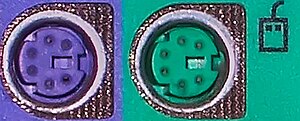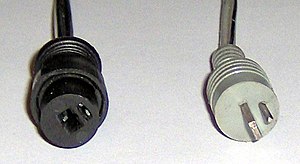Connectors (External): Difference between revisions
(→Jack) |
(→XLR) |
||
| Line 71: | Line 71: | ||
===XLR=== | ===XLR=== | ||
[[File:Xlr-connectors.jpg|thumb|upright=1.35|XLR3 cable connectors female (left) and male]] | |||
XLR connectors are very commonly used for better quality microphones, and audio connections more generally. For these applications they have 3 pins, though other variants exist. The 3 pins allow for balanced audio, that's to say, two of the pins carry the same audio signal but in opposite phase. At the receiving end the equipment doesn't respond to the absolute level of either, but the difference between the two. Any interference picked up along a cable run will be picked up equally in the same phase by both conductors and hence will be cancelled out by the receiving eqipment. | |||
5-pin XLR connectors are used on DMX stage lighting control systems. | |||
====Adapters and Compatibility==== | |||
XLR to jack and phono adapters are available in all possible combinations and genders. | |||
== RF == | == RF == | ||
Revision as of 21:53, 11 March 2023
This page will help you identify many common types of connector.
Summary
There are many types of connector, which can be confusing. This page will help you identify many of them, and in some cases, indicate whether a simple adapter will enable you to connect one type to another.
Safety
- Always make sure that a connector is fully engaged. Never force it, and never pull it by the wire to unplug it.
Audio and Miscellaneous Connectors
Standard DIN
DIN connectors are primarily intended for analogue audio. The commonest are the 5-pin type which were often seen on cassette recorders when they were still much in use. The 5 pins were used for left and right, record and playback, plus ground return.
The same connector is still seen on digital musical instruments such as keyboards where they are used for MIDI. (Note that the MIDI lead marked Out goes into the socket marked In and the lead mark In into the socket marked Out.)
Different versions having from 3 to 8 pins are sometimes seen, occasionally as a power connector or for various other uses. DIN lounspeaker
A DIN loudspeaker connector is the same size but has just two pins, one of which is flat. This is sometimes used asa power connector on Christmas lights.
Mini DIN

This has been used for various purposes. Like the standard DIN, it comes in various configurations from 3 to 9 pins. In the 6 pin variant it's mostly remembered today as the standard PS/2 PC keyboard and mouse connector before USB became the norm. Early USB keyboards and mice often came with a USB to PS/2 adapter. These didn't convert USB to PS/2 - such keyboards simply sensed which protocol to talk by the voltages it sensed o the USB plug.
Older laptops sometimes had a 4-pin mini DIN socket for S-video output.
Phono
Phono, or more correctly RCA connectors are commonly used for audio and video. For stero audio there will be two, usually red and white. For analogue video there may be a single yellow connector for composite video, or red, green and blue for component video, and perhaps yellow and white for horizontal and vertical sync.
Adapters and Compatibility
Audio leads are available to connect two phono connectors to a stereo jack connector.
Video leads or adapter allow you to connect between VGA or SCART connectors and phono connectors.
Jack
Jack (or phone) connectors have an ancestry going back well over 100 years, having first been designed for telephone systems. They have the great advantage that, being round, there is no correct or incorrect orientation in order to get them to mate, making it very quick and easy for a manual telephone switchboard operator to connect a caller.
Modern versions come in 3 sizes: standard 6.35mm (or 1/4"), 3.5mm miniature and 2.5mm sub-miniature, all used almost exclusively for audio, mainly headphones and microphones.
The simplest has just 2 conductors connected to the tip and the sleeve. These are designated TS. For stereo use a ring between the tip and the sleeve allows for a 3rd conductor, and these are designated TRS. The tip is normally the left channel and the ring is the right.
To allow for a microphone as well, there is a second ring, and these jacks are designated TRRS. Combined headphone and microphobe sockets are common on laptops, mobile phones and tablets, but unfortunately there are two different standards for how to connect the microphone, known as CTIA and OMTP.
PC microphones are generally TRS with the ring used to supply a bias voltage required by electret microphones.
TRRRS jacks exist but are unusual. The extra ring can be used for a second microphone or for supplying power.
3.5mm jacks are sometimes used for video, but beware: these may have a 17mm shaft which could damage a socket designed for the more usual 15mm jacks if forced in.
Adapters and Compatibility
Adapters are available for any of the three common sizes to any other, and in the various TS, TRS etc variants. If you want to connect a mono source to a stereo input or vice versa you'll need a correctly wired adapter (or make one up yourself). A headphone splitter allows two 3.5mm headphone jacks to share the output from one 3.5mm headphone socket.
If you need to connected headphones and a separate microphone to a combined socket you can get a suitable adapter with a TRRS plug on one end and two TRRS sockets one for the headphone and the other for he microphone, on the other. But there are two types: CTIA and OMTP. The specification for your laptop should tell you which you need.
You can also get male to male and female to female adapters, and adapters with a jack connector on one end and one or two phono connectors on the other.
XLR
XLR connectors are very commonly used for better quality microphones, and audio connections more generally. For these applications they have 3 pins, though other variants exist. The 3 pins allow for balanced audio, that's to say, two of the pins carry the same audio signal but in opposite phase. At the receiving end the equipment doesn't respond to the absolute level of either, but the difference between the two. Any interference picked up along a cable run will be picked up equally in the same phase by both conductors and hence will be cancelled out by the receiving eqipment.
5-pin XLR connectors are used on DMX stage lighting control systems.
Adapters and Compatibility
XLR to jack and phono adapters are available in all possible combinations and genders.
RF
Aerial
BNC
F
Video Connectors
For a comprehensive list, see List of video connectors in Wikipedia.
SCART
Phono
S-Video
VGA
HDMI - Std, Mini, Micro
DVI - various
DisplayPort
Data Connectors
D-type: 9, 15, 25 pin
RJ45
RJ11
USB A, B, Mini, Micro, C
SATA
PATA
What was the Apple one?
Thunderbolt
Lightning
Power Connectors
Laptop
General purpose round




